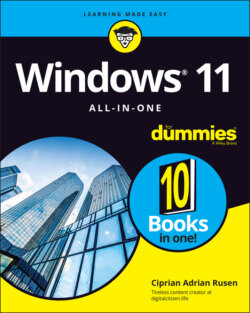Читать книгу Windows 11 All-in-One For Dummies - Ciprian Adrian Rusen - Страница 62
Keyboard Shortcuts
ОглавлениеWindows 11 has hundreds of keyboard shortcuts. I don’t use many of them because they’re difficult to remember. However, some of them are easy to remember and will make your work with Windows 11 a lot easier.
Here are the keyboard shortcuts that everyone should know. They’ve been around for a long, long time:
Ctrl+C copies whatever you’ve selected and puts it on the clipboard. On a touchscreen, you can do the same thing in most applications by tapping and holding down, and then choosing Copy.
Ctrl+X cuts whatever you’ve selected and puts it on the clipboard. Again, you can tap and hold down, and Cut should appear on the menu.
Ctrl+V pastes whatever is in the clipboard to the current cursor location. Tap and hold down usually works.
Ctrl+A selects everything, although sometimes it’s hard to tell what everything means — different applications handle Ctrl+A differently. Tap and hold down usually works here, too.
Ctrl+Z usually undoes whatever you just did. Few touch-enabled apps have a tap-and-hold-down alternative; you usually have to find Undo on a ribbon or menu.
When you’re typing, Ctrl+B, Ctrl+I, and Ctrl+U usually change your text to bold, italic, or underline, respectively. Press the same key combination again, and the text returns to normal.
In addition to all the key combinations you may have encountered in previous Windows versions, there’s a healthy crop of new combinations. These are the important ones:
The Windows key brings up the Start menu.
Windows+A opens Quick Actions.
Windows+E launches File Explorer.
Windows+I opens the Settings app.
Windows+M minimizes all open apps and windows on the current desktop.
Windows+Tab opens task view, with the virtual desktops listed at the bottom. In the middle is a preview of the open apps in each virtual desktop.
Alt+Tab cycles through all running apps on the current desktop, one by one. See Figure 1-11.
Ctrl+Alt+Del — the old Vulcan three-finger salute — brings up a screen that lets you choose to lock your PC, switch the user, sign out, or run Task Manager (see Book 8, Chapter 5).
FIGURE 1-11: Alt+Tab cycles through all running apps.
You can also right-click (or press and hold down on) the Start icon or press Windows+X to display the Power User menu, which is shown in Figure 1-12.
FIGURE 1-12: The Power User menu can get you into the innards of Windows 11.
And finally, the trick I know you’ll use over and over: Whenever you want to type an emoji in a document, hold down the Windows key and press the period key. See Figure 1-13.
Who says Windows 11 isn’t as cool as your smartphone?
FIGURE 1-13: Emojis are — finally! — just a keyboard command away.
